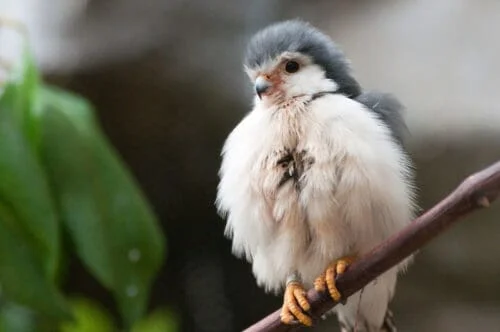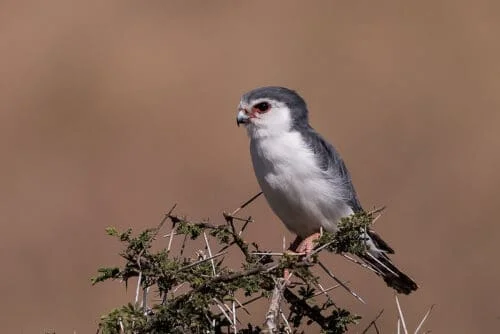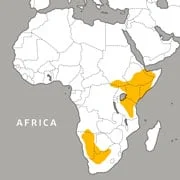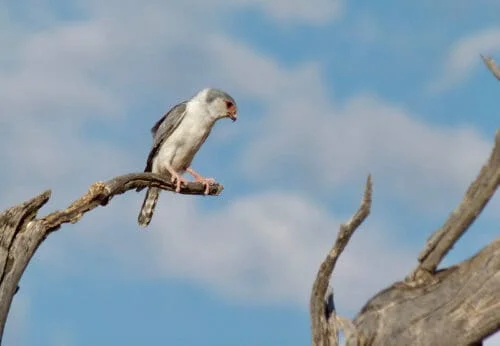While we often marvel at the grandeur of large birds of prey, the world’s smallest falcon, the Pygmy Falcon (Polihierax semitorquatus), proves that size isn’t everything.
This diminutive dynamo has captivated bird enthusiasts with its tenacious spirit and remarkable adaptability. In this article, we’ll explore the enchanting world of the Pygmy Falcon, delving into its striking appearance, unique behaviors, and fascinating habits.
So, let’s take flight and discover what makes this tiny raptor truly extraordinary!

Size and Appearance
The Pygmy Falcon is the epitome of “small but mighty,” measuring a mere 7.5 inches in length with a wingspan of just 14-16 inches. Despite their petite frame, these little raptors display a distinctive coloration that makes them instantly recognizable.
Males exhibit a striking contrast, with a gray head and back, and a white chest adorned with dark barring.
Their white underparts provide a dramatic contrast to their rust-colored leggings.
Females, on the other hand, have a more subdued color palette, with a gray head and back, and a cream-colored chest with faint barring. Both sexes have white cheeks, a black eye stripe, and a double-toothed black beak, giving them a unique and captivating appearance.

Habitat and Distribution: Where to Find the World’s Smallest Falcon
The Pygmy Falcon inhabits arid regions of eastern and southern Africa, spanning countries such as Ethiopia, Somalia, Kenya, Tanzania, and South Africa. Their preferred habitat consists of semi-arid savannas and scrublands, where they often form a unique symbiotic relationship with another local bird species – the sociable weaver.
These tiny falcons have been known to occupy the massive communal nests of sociable weavers, taking advantage of the weavers’ complex network of chambers to create their own living quarters.
This arrangement provides the Pygmy Falcon with shelter and protection, while the weavers benefit from the falcon’s predatory presence, which deters potential nest raiders.

Diet and Hunting: The Smallest Falcon in the Skies
As resourceful hunters, Pygmy Falcons primarily prey on insects, small mammals, and other birds. Their diet includes grasshoppers, crickets, beetles, mice, small lizards, and even small bird species like waxbills and weavers.
These pint-sized predators are swift and agile, often ambushing their prey with rapid strikes from the air or from a concealed perch.
Love in Small Packages: Mating and Reproduction
The Pygmy Falcon’s mating and reproductive habits are as unique as the bird itself. While they are generally monogamous, polyandry – a situation where a female mates with multiple males – has been observed in some instances. Males provide the majority of the parental care, including incubating eggs and feeding the young.
Females lay 2-4 eggs in a chamber within their chosen sociable weaver nest. The incubation period lasts about 28 days, after which the nestlings will remain in the nest for an additional 30 days before fledging. Both male and female Pygmy Falcons take turns feeding and protecting their young during this crucial period.

Conservation Status: A Delicate Balance
Fortunately, the Pygmy Falcon population is currently considered stable, with the species listed as “Least Concern” on the IUCN Red List.
However, these tiny birds face potential threats, such as habitat loss and degradation, which can result from human encroachment and climate change.
To ensure the continued survival of these fascinating raptors, it is essential to support conservation efforts and maintain a healthy and diverse ecosystem.
Conclusion
The Pygmy Falcon may be the world’s smallest falcon, but it undoubtedly leaves a lasting impression on those who are lucky enough to observe it.
With its striking appearance, unique habits, and fearless demeanor, this diminutive dynamo has won the hearts of birdwatchers and nature enthusiasts alike.
The Pygmy Falcon serves as a remarkable reminder that even the tiniest creatures can have a profound impact on the world around them.
So, the next time you find yourself in the African savanna or scrubland, keep an eye out for the enchanting Pygmy Falcon – a tiny titan that truly embodies the wonder of the natural world.
